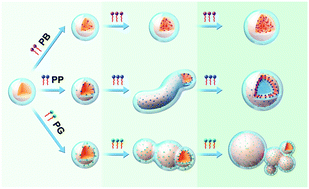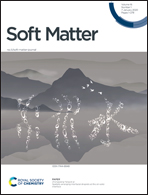Small molecule-mediated self-assembly behaviors of Pluronic block copolymers in aqueous solution: impact of hydrogen bonding on the morphological transition of Pluronic micelles†
Abstract
The influence of hydrogen bonding on the self-assembly behaviors of Pluronic P123 micelles is experimentally and theoretically investigated by introducing three small molecules, i.e. propyl benzoate (PB), propyl paraben (PP) and propyl gallate (PG) into the aqueous solution. It is discovered that the number of phenolic hydroxyl groups and concentration of the tested small molecules exhibit a profound impact on the micellar morphology. Although all the small molecules increase the size and polydispersity of Pluronic micelles in a concentration-dependent manner, the micellar morphologies induced by them vary considerably as demonstrated by DLS and cryo-TEM measurement. PB, without phenolic hydroxyl, cannot bring about the morphological change of P123 micelles, while PP induces a series of morphological transitions from spheres to long worm-like micelles and then to unilamellar vesicles by increasing the PP content. Upon increasing the number of phenolic hydroxyls in small molecules, i.e. PG, the fusion of the intermicellar core takes place, resulting in the formation of large micelles and micellar clusters. A qualitative study by NMR reveals that the different locations of small molecules within the micelles are attributed to the balance of hydrogen bonding and hydrophobic interaction between small molecules and copolymers. In addition, molecular dynamics simulations (MDS) are performed to further confirm the experimental results and provide quantitative information on intermolecular interaction strength. It is supposed that the mechanism of micellar morphological transition mediated by small molecules is ascribed to the hydrogen bonding interactions with varying strengths between the PEO blocks and their phenolic hydroxyls, which governs their locations in micelles, affecting the free energies from different regions of micelles, and consequently leads to the varying micellar morphologies. This study deepens our understanding of the role of hydrgen bonding in the self-assembly behaviors of Pluronic micelles and provides an alternative strategy for manipulating the nanostructure of Pluronic micelles.



 Please wait while we load your content...
Please wait while we load your content...